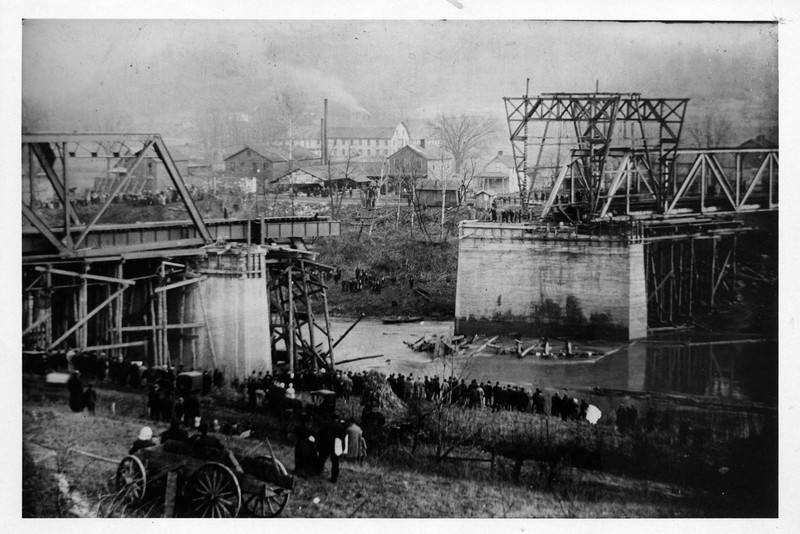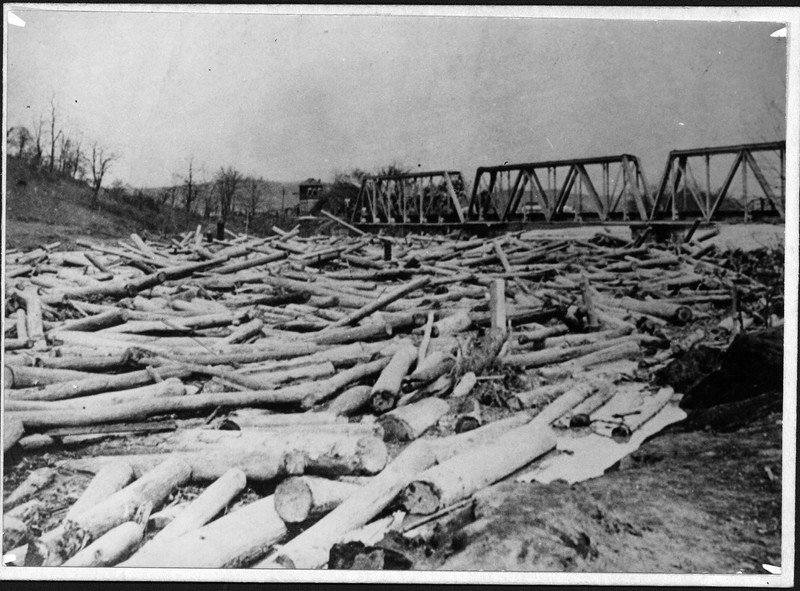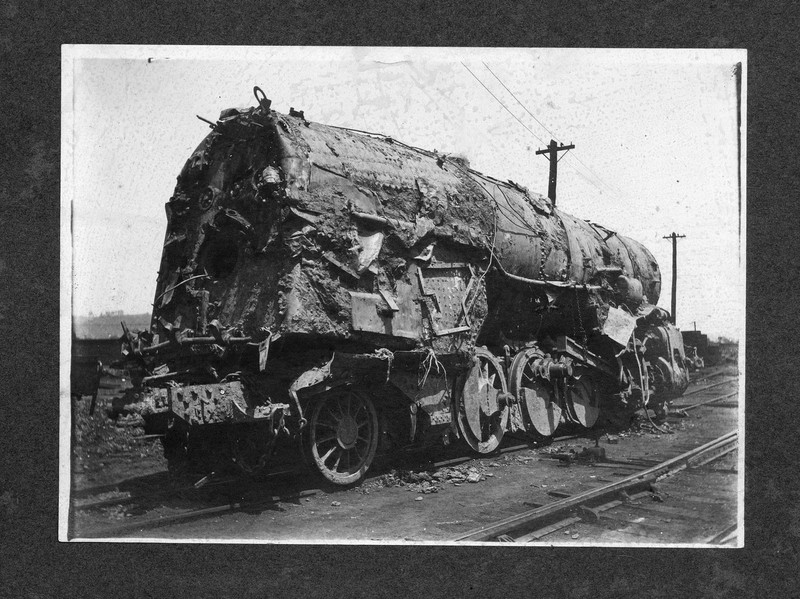Guyandotte Bridge Disaster (January 1, 1913)
Introduction
Text-to-speech Audio
Images
The middle span of the bridge collapsed under the weight of the train, apparently because of the temporary supports in place at the time. Image courtesy of Marshall University Special Collections.

Floating logs jammed up against the bridge. Some claimed that the bridge had been weakened due to rising waters and the supports being rammed by logs. Image courtesy of Marshall University Special Collections.

The badly damaged Engine No. 820 was recovered in June 1913 and eventually returned to service. Image courtesy of Marshall University Special Collections.

Backstory and Context
Text-to-speech Audio
In late 1912 the Chesapeake & Ohio Railroad began a project to repair and double track its bridge crossing the Guyandotte River. The C&O line on either side of the bridge already had two tracks, so the single track present on the bridge created a bottleneck for traffic. In December the water level of the Guyandotte River rose significantly, and many locals began to fear that the bridge could be damaged by logs. West Virginia had a flourishing timber industry at this time, and it was common for logs to be floated down the Guyandotte and other rivers to be taken to the Ohio River. These logs, which could number in the thousands, were held together by barriers called log booms. During times of flooding however these logs could break free from the booms, and cause incredible damage to anything in their path.
The Guyandotte community had experienced problems with floating logs during times of flooding in the past. In November 1906 a previous bridge was destroyed after being swept away by logs; in July 1907 the replacement bridge was destroyed by another wave of logs, reportedly numbering around 125,000. In December 1912 many were concerned that the C&O bridge was especially vulnerable to logs during the renovations because the middle portion of the bridge was held by a weaker, temporary support referred to as a “falsework.” On December 31 the Huntington Advertiser ran an article claiming that the bridge was in grave danger. After the disaster witnesses claimed that the bridge had been rammed numerous times recently by escaped logs, weakening the structure.
On the morning of January 1, 1913 freight train No. 99 departed from Hinton and headed west on a trip to Russell, Kentucky. The train was pulled by C&O Engine No. 820, which was a 2-8-2 Mikado model. Weighing at over 490,000 pounds, it was much larger than the typical locomotives that crossed the Guyandotte bridge. The train reached the bridge at around 10:25 am. Thirty men were working on the bridge at the time, and several trains had already safely crossed it.
A flagman halted the train before it crossed because another train was already on the bridge, delivering materials for the workers. The supply train departed and at 11:00 am Engine No. 820 proceeded to cross the bridge. Some accounts claim that a worker warned the train’s engineer, Charles B. “Shorty” Webber, that it was too heavy to cross the bridge, but Webber disregarded the concern. Reportedly one crew member and several bridge workers fled because they did not believe the bridge could support the train. No. 820 reached the middle span of the bridge, which promptly collapsed. The locomotive and one boxcar plunged into the icy river, taking thirteen bridge workers down with it.It was New Year's morning, nineteen hundred and thirteen,
Engine eight-hundred and twenty went down with fire and steam.
It was on this sad morning at about eleven o'clock,
The C&O bridge at Guyandotte began to tremble and rock.
-"The Guyandotte Bridge Disaster"
Seven people died and fifteen were injured in the collapse. Those killed were engineer Charles B. Webber and bridge workers Henry White, Charles Maddie, Emmett Wood, James Crawford, Charles Coyner, and James G. Wheeler. Within hours around 2,500 people gathered on the riverbanks to witness the recovery operation. Three of the bodies were never found. The bridge was a total loss, and rail traffic on that portion of the C&O line was completely frozen for ten days; some traffic was diverted to the Baltimore & Ohio line. The disaster cost the C&O approximately $500,000 in damages and lost revenue. The bridge was eventually rebuilt. Engine No. 820 remained buried deep in the sand beneath the river, and it was not until June 1913 that the C&O managed to recover it. The mangled wreck of the train was brought to the C&O shops in Huntington, where it was rebuilt and put back into service.
The collapse of the Guyandotte River Bridge was one of the worst train accidents to occur in the C&O Railroad’s history. The incident inspired the anonymous composition of a ballad called “The Guyandotte Bridge Disaster,” which was believed to have been written days after the tragedy. It was never determined whether the bridge collapsed due to damage from floating logs, the enormous pressure of the locomotive on the middle span’s temporary supports, or a combination of both.
Sources
“Bridge Goes Down.” Topeka State Journal. January 2, 1913.
Dickinson, Jack and Kay Stamper Dickinson. Lumbermen, Log Rafts, and Sawmills: The Lumber and Timber Industry in Southern West Virginia. 2016.
“Eight Killed in Wreck.” New York Times. January 2, 1913.
Long, Roy C. “Railroad Recollections: ‘Bridge Falls with Engine, E. F. Weber Killed.’” Hinton News. November 2, 1999. Accessed July 30, 2019. http://hin.stparchive.com/Archive/HIN/HIN11021999P02.php.
Mills, Don. “Guyandotte Disaster.” Cabell Record. February 3, 2005.
“Terrible Accident.” Madisonian. January 1, 1913.
